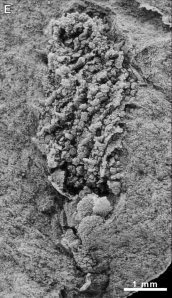Damn, I said I wasn’t going to talk about the Moroccan helicoplacoid-on-stalk, but it’s just so. Bloody. Amazing.
Here it is in its full glory, from the supplementary figures of Smith and Zamora (2013). Left is a cast of a young specimen, right is the authors’ reconstruction of the adult creature:
So… the thing is a transitional form all right. It’s got a little stalk and cup like eocrinoids, built with a rather irregular arrangement of mineralised plates. On top of that it has a spiral body like helicoplacoids. It has ambulacra, the “rays” with porous plates where the tube feet that characterise living echinoderms can come out. This photo of the underside of a starfish is a pretty nice illustration of ambulacra (the white regions with little holes) and tube feet:

Even more interestingly, the new beastie (christened Helicocystis moroccoensis by the authors) seems to have five of them, like modern echinoderms (and a lot of extinct types, including eocrinoids). Helicoplacoids do have ambulacra, but only three or a single Y-shaped one, depending on interpetation.
Again unlike (one interpretation of) helicoplacoids but like modern echinoderms, the mouth of Helicocystis is right at the stalkless end. It’s also surrounded by an arrangement of skeletal plates that resembles more “conventional” echinoderms and has no equivalent in helicoplacoids proper. It’s about as neat a transitional form as you could hope for.
The question is which way the transition goes. It could be that the familiar five-rayed echinoderms are derived from a helicoplacoid-like ancestor, going through something like this guy. Or it could be that helicoplacoids are actually weird even for echinoderms, and their ancestors were more conventional stalked, five-armed beasties that lost their proper echinoderm shapes via something like Helicocystis.
Smith and Zamora actually did a phylogenetic analysis, but it’s not that helpful IMO. The tree in the paper is very pretty, and it says Helicocystis is the next branch after helicoplacoids on the path leading to “proper” echinoderms. The tree in the supplementary figures actually has measures of statistical support on it – which pretty confidently put Helicoplacus, Helicocystis, and a bunch of less weird echinoderms, together.
However, the relationships within that group are, shall we say, a little bit fluid. Granted, I come from a more sequency background and don’t often have to deal with morphology-based trees or parsimony as the method of analysis – but I’d definitely view a 56% bootstrap support with a big dose of scepticism, and this is the number they got for the hypothesis that Helicocystis is more closely related to “proper” echinoderms than to Helicoplacus. The other measure they display doesn’t make me any more confident about the relationship.
(I find it kind of amazing they got any resolution at all in that tree – with only 17 characters, some of which aren’t applicable to all species, and only nine species to begin with… yeah. The whole phylogenetic analysis is far from ideal even if it’s the best they could think of.)
So, based on that tree, the phylogenetic hypothesis they present is, at this point, just a plausible hypothesis. That doesn’t lessen the value of Helicocystis, though. The creature is still a damn neat transitional form – we just can’t be terribly sure which way the transition went.
There’s some interesting speculation in the paper about developmental evolution (yay!). Smith and Zamora point out that the spirally bit in Helicocystis looks like a complete helicoplacoid; the stalk and cup are kind of tacked onto that. The tissues of most modern echinoderm adults come from two different places: regular old tissues of the larva, and a special set of cells set aside for adult-making purposes*. So Smith and Zamora hypothesise that the two-part body of Helicocystis marks the point where this dual origin appeared. (Or, if they’re wrong about the phylogeny, the point where proto-helicoplacoids lost it?)
There’s also another interesting bit of evo-devo speculation (mixed with a bit of “eco”) about the stalk. Full-grown Helicocystis have pretty small stalks compared both to their own young and more typical stalked echinoderms. The authors wonder if this is because stalks for attachment originally functioned to help young echinoderms settle in a comfortable place, and only later became important for adults. I’m not sure how much sense that actually makes, and of course we only have a single species of Helicocystis to go by, but hey, ideas are fun.
Helicocystis has a random weird quirk as well, in that its spirals curl the opposite way to every proper helicoplacoid. That sort of variation happens even within species (e.g. in snail shells), but isn’t it a weird coincidence that such a unique creature should also twist the wrong way?
One thing is for sure: this beast is made of pure, distilled awesome. I think we should make a new Archaeopteryx out of it. Invertebrates need their evolutionary icons, too!
***
*And that’s a nice reminder for me, because I thought they basically threw away the larva. Apparently I need a refresher on echinoderm development. Or just a reminder that not all echinoderms are sea urchins. The funny thing is a couple of years ago I actually specifically read and puzzled over literature discussing what comes from where in various echinderms…
***
Reference:
Smith AB, Zamora S (2013) Cambrian spiral-plated echinoderms from Gondwana reveal the earliest pentaradial body plan. Proceedings of the Royal Society B advance online publication 26/06/2013, doi:10.1098/rspb.2013.1197


One thought on “I couldn’t resist”